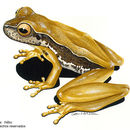Description
provided by AmphibiaWeb articles
Dorsal coloration is uniform beige-bronze or green with occasional dark spots (Savage and Heyer 1968). A bright dorsolateral cream stripe extends from snout to groin, and is bordered below by a dark brown band, which is bordered by a light brown line in turn bordered by thin white lines. The venter is yellow flecked with black or brown spots, which distinguishes this species from neighboring species that have light dorsolateral stripes (Savage and Heyer 1968). Limbs have dark brown spots on the dorsal aspect, and the posterior thigh and plantar surface of the foot are suffused with yellow or greenmelanophores. The dorsum and the underside of the legs are smooth, while the venter is granular, and the heel is slightly warty. The snout is sub-elliptical to pointed in dorsal outline, and rounded in profile. The iris is orange-bronze with a central dark brown band and is at least twice the size of the tympanum, and the upper lip and lore is golden-bronze (Savage and Heyer 1968). There is no hand webbing and the toes are about one half webbed (vestigal between toes I and II), but both hands and feet bear large discs (Duellman 1970). Male vocal sacs are internal, paired, and lateral (Savage and Heyer 1968). The mating call has been described as a pair of short, pulsed and poorly modulated notes (Duellman 1970).A Spanish-language species account can be found at the website of Instituto Nacional de Biodiversidad (INBio) (http://darnis.inbio.ac.cr/FMPro?-DB=UBIpub.fp3&-lay=WebAll&-Format=/ubi/detail.html&-Op=bw&id=4187&-Find).
Arosemana, F.A., and Ibanez, D.R. (1991). ''Hyla angustilineata (NCN).'' Herpetological Review, 22(4), 133.
Distribution and Habitat
provided by AmphibiaWeb articles
The habitat is humid forest, classified in the lower montane zone by Holdridge (1967). H. angustilineata is found in the Cordilleras Central, Tilaran, and Talamanca in Costa Rica, and in Panama's Parque Internacional La Amistad, Cerro Horqueta (Arosemana and Ibanez 1991).
Life History, Abundance, Activity, and Special Behaviors
provided by AmphibiaWeb articles
Not much is known about the natural history of H. angustilineata, except that the breeding season includes March and April (though it may occur more than once a year), and that oviposition and male calling takes place in water filled depressions (Duellman 1970).
Life History, Abundance, Activity, and Special Behaviors
provided by AmphibiaWeb articles
No population data has been reported for this species.
Narrow-lined tree frog: Brief Summary
provided by wikipedia EN
The narrow-lined tree frog (Isthmohyla angustilineata) is a species of frogs in the family Hylidae found in the mountains of Costa Rica and western Panama. Its natural habitats are humid lower montane rainforests. It is a nocturnal species that breeds in small puddles and water-filled depressions.
Population declines of this species have been attributed to chytridiomycosis. It is found in several protected areas.
- license
- cc-by-sa-3.0
- copyright
- Wikipedia authors and editors

